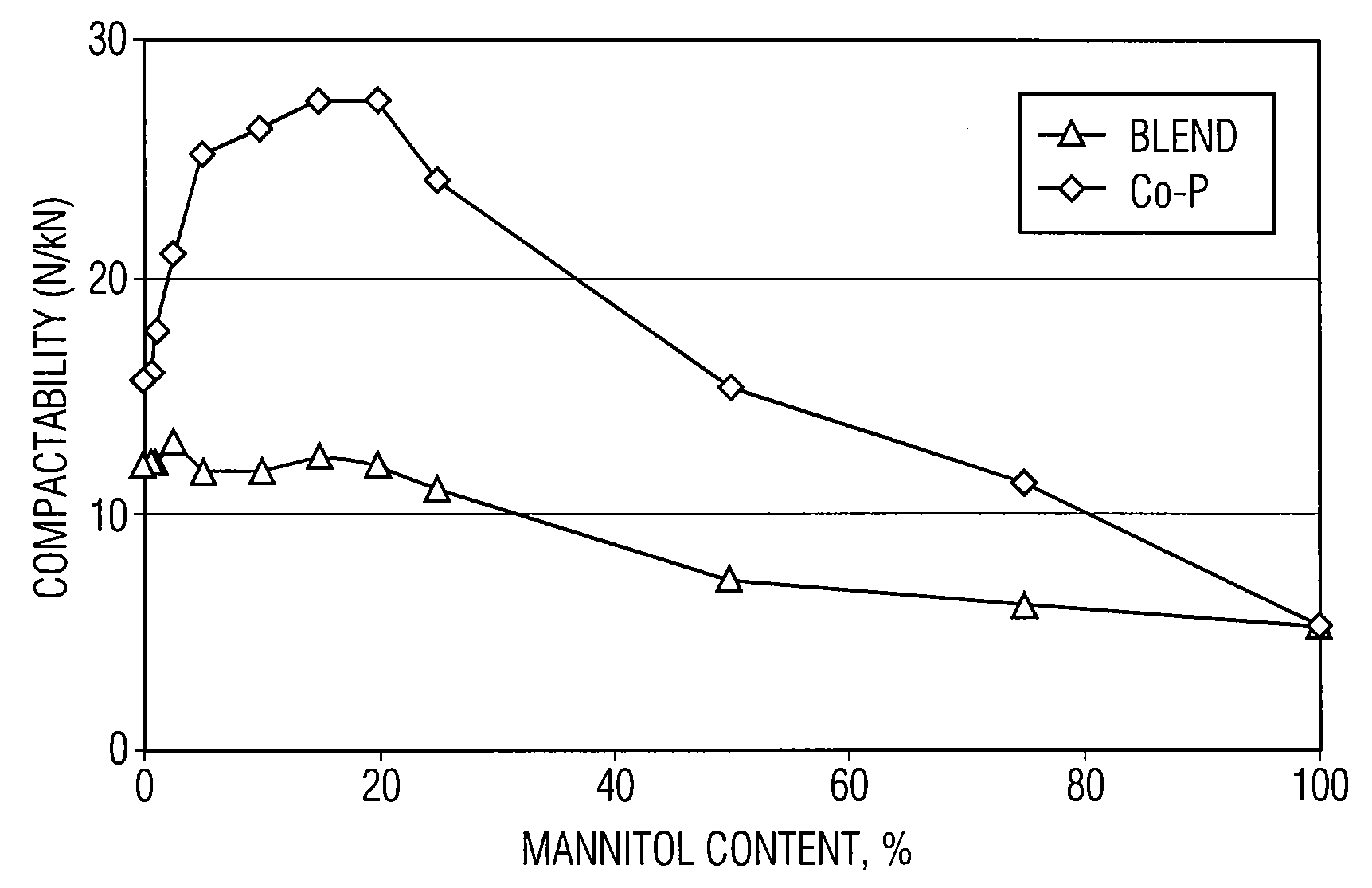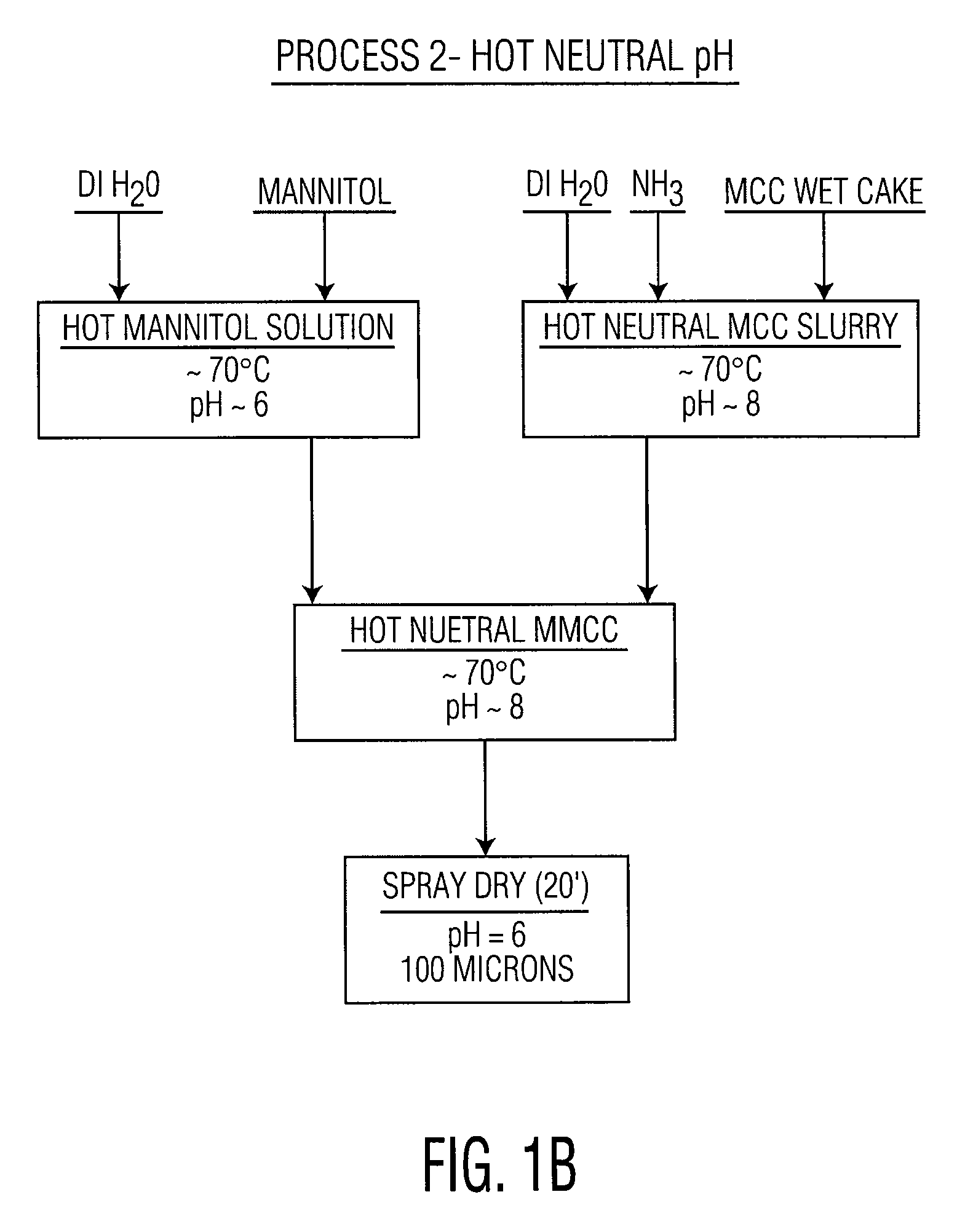Co-processed microcrystalline cellulose and sugar alcohol as an excipient for tablet formulations
a technology of microcrystalline cellulose and sugar alcohol, which is applied in the field of composition, can solve the problems of direct compression limitation, reduced tablet strength or hardness, etc., and achieve the effect of improving compactability
- Summary
- Abstract
- Description
- Claims
- Application Information
AI Technical Summary
Benefits of technology
Problems solved by technology
Method used
Image
Examples
example 1
[0066]This example illustrates formation of a co-processed microcrystalline cellulose / sugar alcohol by two different processes. FIG. 1A shows Process 1, a cool, low pH process. It uses ambient temperature water and involves adding acid MCC wetcake to a mannitol solution to form a mixture of MCC and mannitol (“MMCC”), which is, optionally, neutralized with ammonia. The resulting slurry (“Cool Neutral MMCC”) is spray dried. FIG. 1B shows Process 2, a hot, neutral pH process. Acid MCC wetcake is added to 70° C. water and, if necessary, neutralized with ammonia. Then a 70° C. mannitol solution is added to the neutralized MCC slurry. The resulting slurry (“Hot Neutral MMCC”) is spray dried.
[0067]The compaction profiles of 90% MCC / 10% mannitol compositions produced by these processes are shown in FIG. 2. There is no significant difference in the compactability of the samples made by processes 1 and 2
example 2
[0068]This example illustrates evaluation of co-processed MCC / sugar alcohol samples prepared by Process 1 of Example 1. MCC (PH grade wetcake) and mannitol (USP / NF grade) were co-processed as described in Process 1 of Example 1. Samples were produced with batch solids content necessary to solubilize all of the mannitol in each batch (mannitol solubility in water, about 18% solids at 25° C., pH about 5.2). Six samples were produced and spray dried on a 2.44 M (8 ft) Bowen dryer using standard MCC operating conditions. Inlet temperature 198-232° C.; outlet temperature 82-118° C. Samples were produced with 25%, 50% and 75% mannitol at two pH levels of 3.7 (unneutralized) and 5.8 (neutralized with NH4OH to pH 8). The physical properties of the samples are summarized in Table 1.
TABLE 1MannitolLODa>200 mesh (75 μm)LBDbSample #(%)(%)(%)(g / ml)pH1-1252.770.393.71-2501.7100.473.51-3751.350.453.41-4251.880.415.71-5501.430.485.81-6751.130.476.1aLoss on Drying.bLoose Bulk Density
example 3
[0069]Five additional samples of co-processed MCC / mannitol were produced as described in Example 2. Samples were produced with 0, 5, 10, 15, & 20% mannitol at pH 6.0. The physical properties of the samples are summarized in Table 2.
TABLE 2MannitolLOD>200 mesh (75 μm)LBDSample #(%)(%)(%)(g / ml)pH2-103.0150.385.72-252.7180.356.12-3102.8210.376.12-4152.3240.386.12-5202.3210.406.1
PUM
| Property | Measurement | Unit |
|---|---|---|
| Fraction | aaaaa | aaaaa |
| Density | aaaaa | aaaaa |
| Particle size | aaaaa | aaaaa |
Abstract
Description
Claims
Application Information
 Login to View More
Login to View More - R&D
- Intellectual Property
- Life Sciences
- Materials
- Tech Scout
- Unparalleled Data Quality
- Higher Quality Content
- 60% Fewer Hallucinations
Browse by: Latest US Patents, China's latest patents, Technical Efficacy Thesaurus, Application Domain, Technology Topic, Popular Technical Reports.
© 2025 PatSnap. All rights reserved.Legal|Privacy policy|Modern Slavery Act Transparency Statement|Sitemap|About US| Contact US: help@patsnap.com



